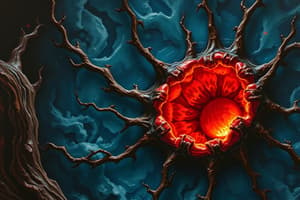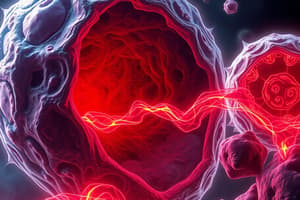Podcast
Questions and Answers
A patient's biopsy reveals that the normal columnar epithelium in their esophagus has been replaced by stratified squamous epithelium. This cellular adaptation is most likely a result of which of the following?
A patient's biopsy reveals that the normal columnar epithelium in their esophagus has been replaced by stratified squamous epithelium. This cellular adaptation is most likely a result of which of the following?
- Metaplasia as a protective mechanism against injury (correct)
- Hypertrophy due to increased acid exposure
- Hyperplasia in response to chronic inflammation
- Atrophy following decreased nutrient supply
Cardiac muscle cells are classified as labile cells, meaning they can readily divide and regenerate after injury.
Cardiac muscle cells are classified as labile cells, meaning they can readily divide and regenerate after injury.
False (B)
What is the primary difference between apoptosis and necrosis in terms of inflammation?
What is the primary difference between apoptosis and necrosis in terms of inflammation?
Apoptosis does not cause inflammation, while necrosis does.
Tissue death resulting from a lack of blood supply is termed an ______.
Tissue death resulting from a lack of blood supply is termed an ______.
Match the following cell adaptation with their description:
Match the following cell adaptation with their description:
Flashcards
Hypertrophy
Hypertrophy
Increase in cell size, leading to enlarged tissue/organ size.
Hyperplasia
Hyperplasia
Increase in cell number, leading to enlarged tissue/organ size.
Atrophy
Atrophy
Decrease in cell size, resulting in reduced tissue/organ size.
Apoptosis
Apoptosis
Signup and view all the flashcards
Metaplasia
Metaplasia
Signup and view all the flashcards
Study Notes
- Study notes on Cell Adaptation & Death
Cell Types
- Epithelial cells include squamous, cuboidal, and columnar types, found in skin and intestines
- Connective tissues include fibroblasts, adipocytes, and chondrocytes, found in bone, cartilage, and fat
- Other cell types include muscle cells (skeletal, cardiac, and smooth) and neurons
Cell Division
- Labile cells constantly divide, exemplified by skin and gut epithelium
- Stable cells divide when needed, such as in the liver and kidneys
- Permanent cells cannot divide, like neurons and cardiac muscle
Apoptosis vs Necrosis
- Apoptosis is programmed cell death that occurs without inflammation
- Necrosis is uncontrolled cell death which causes inflammation
Infarct
- Infarct is tissue death that occurs due to lack of blood supply, for example, myocardial infarction
Factors for Atrophy
- Factors that determine atrophy or infarction: blood supply, oxygen availability, workload, and hormonal signals
Effects of Ageing
- Ageing effects on cells and organs: reduced cell division, DNA damage, accumulation of waste products, and organ shrinkage
Adaptation & Reversibility
- Cellular adaptation includes: Hypertrophy (increase in size), Hyperplasia (increase in number), Atrophy (decrease in size), and Metaplasia (change in cell type)
- Cellular adaptation notes: Most adaptations are reversible except metaplasia if it progresses to dysplasia
Metaplasia
- Metaplasia is a change from one cell type to another, for example, smoking causes columnar cells in the bronchi to become squamous
Type of Cell Death
-
Cell death occurs in normal embryogenesis and inflammatory response
-
Apoptosis occurs without inflammation
Increase in Size
- Cellular processes leading to tissue or organ size increase: Hypertrophy (cell enlargement) & Hyperplasia (cell multiplication)
Decrease in Size
- Cellular processes leading to tissue or organ size decrease: Atrophy (cell shrinkage) & Apoptosis (programmed cell death)
Cell types
-
Neurons and cardiac muscle cells are examples of permanent cell types
-
Stratified squamous epithelium, such as in skin and the esophagus, is best for withstanding physical stress
Studying That Suits You
Use AI to generate personalized quizzes and flashcards to suit your learning preferences.



